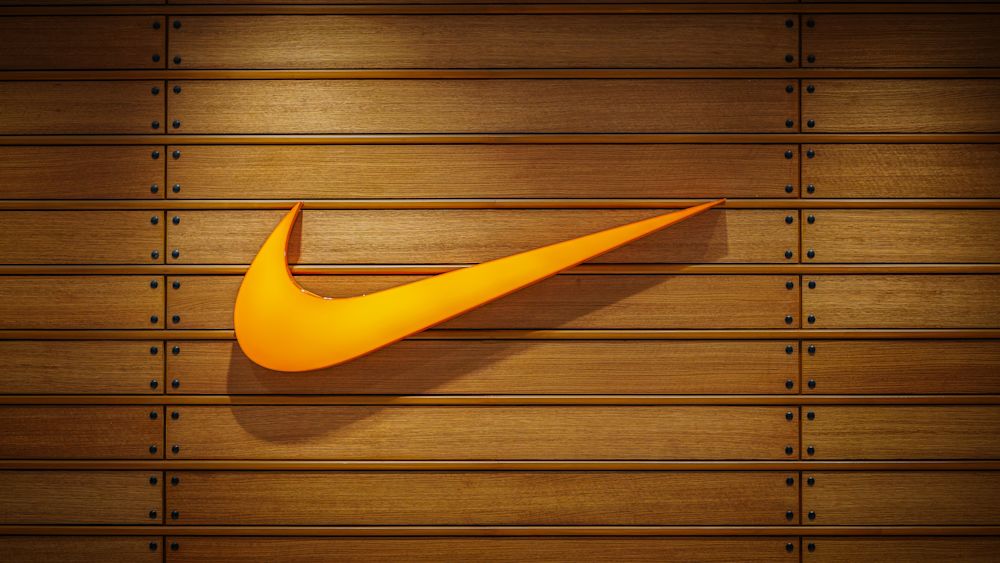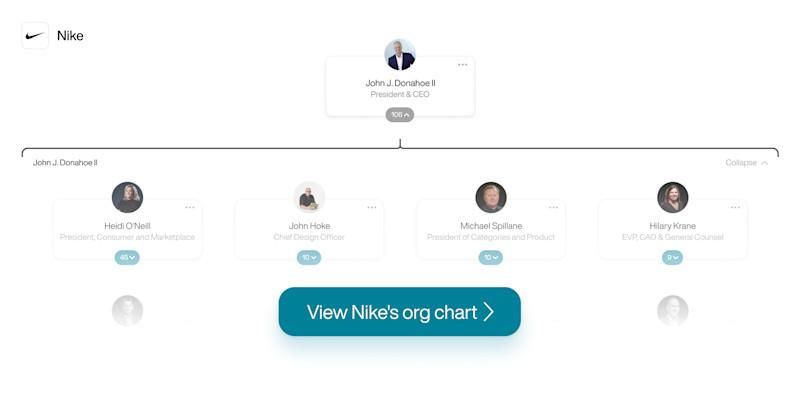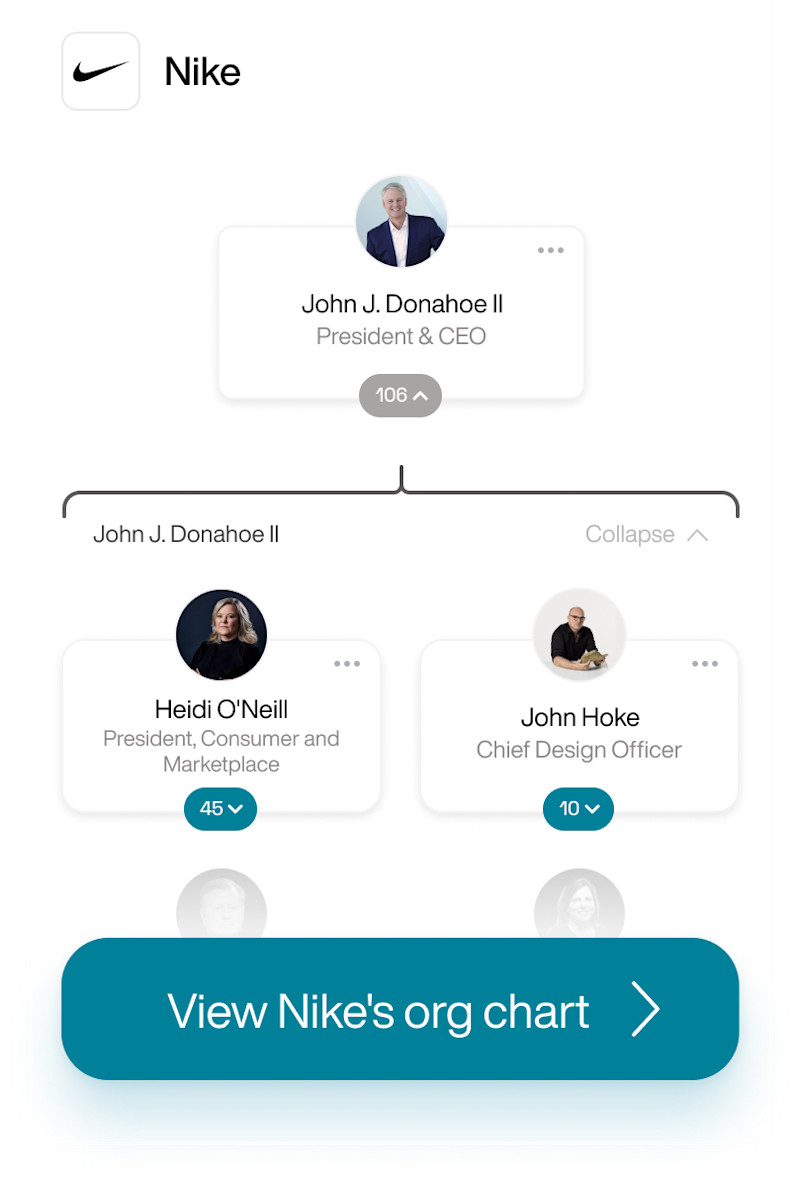- Iterate
- Meet The Team
- The Most Influential People Behind the Scenes at Nike
The Most Influential People Behind the Scenes at Nike
The Org has identified the most influential people behind the scenes at Nike, the world’s most popular and biggest sportswear company. Here’s our exclusive org chart of the top executives and their roles.

The Org has identified the most influential people behind the scenes at Nike, the world’s most popular and biggest sportswear company. Here’s our exclusive org chart of the top executives and their roles.


John Donahoe sits on top of a sportswear company that’s famous worldwide, and whose brand was built around one of the most recognized slogans today, “Just Do It.” In 55 years, Phil Knight’s dream of making a better running shoe for athletes has become a business worth over $130 billion. Nike has long been defined by its innovation, cutting-edge marketing campaigns, brand positioning, and more recently, its digital prowess.
In January, the company embarked on a new chapter in its history when Donahoe, the second outsider ever to serve as president and CEO, took over the reins from Mark Parker, Nike’s longtime chief executive. Parker, who is a four-decade Nike veteran, remains as executive chairman of the company leading the board.
A major pillar of Nike’s success has been its partnerships with some of the world’s best-known athletes. And none has been more game-changing and lucrative for Nike than its endorsement deal with Michael Jordan.
In 1984, Nike and Jordan, then an NBA rookie, teamed up to launch one of the most iconic athlete-endorsed brands in the history of sports – the Jordan brand. ESPN’s recent Michael Jordan documentary “Last Dance,” the most-watched documentary in its history, has reminded us again of how the legendary player has forever changed the game of basketball, both on and off the court.
Nike’s bet on Jordan turned out to be a slam dunk with sales of over $100M in basketball shoes and apparel by the end of 1986. In 1997, with the huge success of the Jordan franchise, Nike spun it off into its own brand. Today, Nike’s Jordan brand operates as a subsidiary with its own identity and team led by Craig Williams, a former Coca-Cola executive who took charge in January of last year. The Jordan brand generated $3.1 billion in sales in Nike’s last fiscal year, and reported its first-ever billion-dollar quarter in December.
The $100 billion-plus global athletic shoe market is another area in which Nike has dominated for years, with its unwavering focus on creating cool, innovative footwear. Much of this can be attributed to Tinker Hatfield, one of the world’s most renowned sneaker designers. He joined Nike in 1981 and is now its VP of Design and Special Products. Hatfield has designed many of Nike’s most popular sneakers, including the Air Jordan 3 through 15, the Air Jordan XX, XXIII, XXV and XXIX, as well as the Air Max 1, Air Trainer and Air MAG.
The sportswear giant suffered a setback in 2018, when a sweeping investigation into numerous allegations of inappropriate workplace behavior and discrimination against female employees resulted in a wave of senior executive departures.
The major shake-up of Nike’s top ranks included a group of executives who oversaw some of the most important departments at the company. A key exit was that of Nike brand president Trevor Edwards, who had been widely seen as a top candidate to become the company’s next chief executive. Despite the heat Nike has taken from this controversy, the company continues to draw in customers with global sales rising each year since 2011.
In October 2019, Nike announced that Parker, under whose leadership the company saw tremendous growth but also weathered a series of controversies, would be stepping down in January. Donahoe was named as Parker’s successor, bringing with him experience leading large digital businesses from his time as CEO of eBay and cloud-computing company ServiceNow, and familiarity with Nike from his experience serving on the company’s board.
Donahoe made has first major move in shuffling Nike’s leadership team this February, one month after stepping into his new role as CEO.
Former CFO Andy Campion took over from Eric Sprunk as chief operating officer. Matthew Friend, the finance chief of a Nike division and vice president of investor relations, took Campion’s place as CFO. Heidi O’Neill, a 21-year Nike veteran and president of Nike Direct, was promoted to lead Nike’s consumer business replacing Elliott Hill, elevating a woman to one of the company’s most senior executive roles. Sprunk and Hill, both longtime Nike executives, are leaving the company later this year. Donahoe said that filling the roles with internal candidates demonstrated the strength of the company’s management bench.
As Nike looks to the future, it continues to focus on digital efforts to engage consumers directly, as online sales revenue was up 36% in the most recent quarter despite the coronavirus turmoil. Industry analysts say that Donahoe’s experience in e-commerce and technology, combined with his track record as a proven CEO, positions him well to lead Nike as it continues its digital transformation into a retail tech company.
--
Sign up now: Stay up to date, level up and hire better with our behind the scenes newsletters at the world’s top startups.
In this article


The ORG helps
you hire great
candidates
Free to use – try today